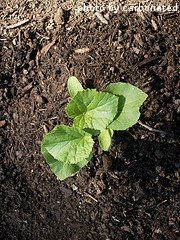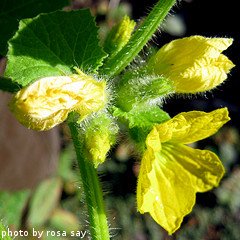How To Plant Cantaloupe
Looking for information about how to plant cantaloupe? You've come to the right place. When planting cantaloupe, it's best to sow the seeds directly in the garden. Cantaloupe typically don't tolerate it when their roots are disturbed. Many times, this will cause the plant to fail. For this reason, it's usually not a good idea to transplant cantaloupe seedlings into your garden.
Before planting cantaloupe seeds in your garden, think carefully about where you want your cantaloupe plants to grow. With most varieties, the vines run a good distance, so you'll need a spot that is far enough away from other plants in your garden.
Cantaloupe seeds should be planted after all danger of frost has passed and when the soil temperatures have warmed to around 70 degrees. They require well-drained, well-tilled, fertile soil and should be planted in an area that gets at least 8 hours of sunlight per day.
How To Plant Cantaloupe Step By Step

Start by tilling the soil to a depth of at least 6-8 inches. Then use a garden rake or a hoe to create mounds about 6 inches high and 4 feet across. The mounds should be spaced at least 6 feet away from any other mound or plant in your garden. Cantaloupe plants spread out and get large, so they need plenty of room. Poke 6-8 holes in the mounds with your finger, spacing them evenly. The holes should be about 1/2 inch deep. Drop a seed into each hole and cover it with loose soil. After planting cantaloupe seeds, water them in well. The seedlings will appear in about 10 days, depending upon the weather and soil temperatures.
In our own garden, we spread out a balanced granular fertilizer before we even plant our cantaloupe seeds. Once the ground is well tilled, we scatted the fertilizer at a rate of 1 pint per 100 square feet of garden space. We also add pulverized lime as our soil is a bit acidic and lacks calcium. We then till the soil one more time, just to work in the fertilizer and lime. Then we use a shovel to create the mounds.
The mounds serve a couple of different purposes. First, they help with drainage and almost guarantee that your cantaloupe roots won't end up sitting in soggy soil. The mounds also ensure that the soil where the seeds are planted is nice and airy and not at all compact. Airy soil allows the roots plenty of room to spread out a little bit before going deep. The mounds also give you a clear sign exactly where you planted your cantaloupe seeds. If for some reason your seeds don't germinate, you'll know exactly where you planted them.
When the seedlings reach about 3 inches tall, remove all but the 3-4 healthiest seedlings per mound. This will give the plants plenty of room so they won't have to compete for water and nutrients.

If you live in a cooler climate, you may have no choice but to start the seeds ahead of time in small pots. If this is the case, choose peat pots or other biodegradable pots that can be planted directly in the ground. Our favorite way of doing this is by using newspaper and a potmaker to make our own biodegradable pots. If you don't have to remove the cantaloupe seedlings to transplant them, they will have a much higher success rate.
Start by filling the peat pots with good garden soil or top soil. Press a cantaloupe seed about 1/2 inch into the soil and cover with more dirt. Water the seeds in well and keep moist by watering every couple of days. Place the pots in a warm indoor spot that gets as much sun as possible. Go ahead and plant the seeds about 4 weeks before it will be warm enough to transplant them into your garden.
To make your soil warm up quicker, you can cover the area where you want to grow cantaloupes with black plastic. This will absorb heat and cause the soil to warm faster.
When the soil is warm enough for transplanting cantaloupe seedlings, create the mounds as described above. Using a trowel, dig 3-4 holes in each mound, about the depth of the peat pots. Space the holes evenly apart. Tear off the bottom of the pots and plant the seedlings and remaining pot in the holes you dug. Back-fill any empty space with loose dirt and tamp down lightly. After transplanting, water the seedlings in well. At this point, it wouldn't be a bad idea to also apply a balanced, water soluble fertilizer product, just to give the seedlings a bit of a boost.
Now that you know all about how to plant cantaloupe, it's time to learn about watering and fertilizing them.

Click here to learn about watering and fertilizing cantaloupe
Click here to learn about harvesting cantaloupe
Click here for some of our favorite cantaloupe recipes
Click here for information about different cantaloupe varieties
Click here to move from our How To Plant Cantaloupe page to our Growing Cantaloupe main page
Click here to go to our Home page